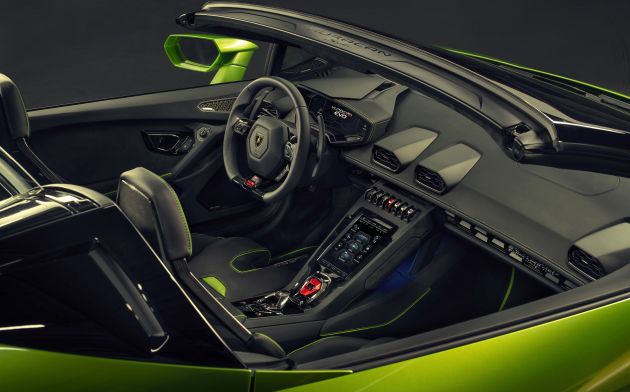It was only a matter of time before Lamborghini presented a Spyder version of its latest baby bull, and here it is. This is the new Huracan Evo Spyder, and it offers the same running gear as the regular hardtop, with the pizzazz of a convertible.
The engine is a 5.2 litre naturally-aspirated V10 derived from the Huracan Performante, and it produces 640 PS and 600 Nm of torque. All that power is sent to the wheels via a seven-speed dual-clutch transmission and a Haldex electronically controlled all-wheel drive system with rear mechanical self-locking differential.
It’s fast too, as the zero to 100 km/h sprint will take just 3.1 seconds, the 0-200 km/h in 9.3 seconds, while the top speed is 325 km/h. However, it isn’t quite as quick as the hardtop, which accomplishes the first two feats in 2.9 and nine seconds respectively.
This performance disparity is largely due to the Spyder’s 1,542 kg dry weight, which is 120 kg more than the hardtop. The excess heft is dedicated to the electrohydraulic soft top that can be raised or lowered in just 17 seconds, at driving speeds of up to 50 km/h.
The soft top also requires a redesign of the rear deck, resulting in the upper intakes being isolated from the roof, rollover protection being added and a new engine cover being fitted. There’s also an integrated duct between the fins to reduce the turbulence in the headroom when the top is down.
Beyond the changes to accommodate the folding roof, the rest of the Spyder looks identical to the hardtop. This includes the interior, which sports an 8.4-inch capacitive touchscreen with multi-finger gesture control, operating the seats, climate control and infotainment (including Apple CarPlay).
Said unit is also linked to display the status of the Lamborghini Dinamica Veicolo Integrata (LDVI), the vehicle’s “brain” that not only integrates and controls all of the car’s electronics, but also predicts the driver’s next move and needs to meet them.
This system is backed by the version 2.0 of the Performante’s Lamborghini Piattaforma Inerziale (LPI), a group of accelerometers and gyroscope sensors placed at the car’s centre of gravity.
Depending on the selected drive mode (Strada, Sport or Corsa), in the Adaptive Network Intelligent MAnagement (ANIMA) system, the LDVI adjusts the car’s magnetorheological suspension and all-wheel drive system to respond to the driver’s steering wheel, braking, acceleration and gear inputs. Rear-wheel steering and a four-wheel torque vectoring system are also controlled by LDVI.
Source: Read Full Article



